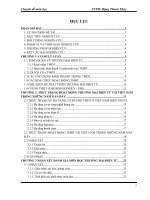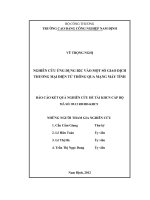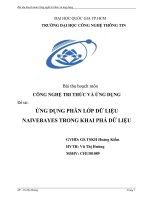Ứng dụng phân tích dữ liệu lớn trong thương mại điện tử góc nhìn từ phía doanh nghiệp và khách hàng
Bạn đang xem bản rút gọn của tài liệu. Xem và tải ngay bản đầy đủ của tài liệu tại đây (3.09 MB, 229 trang )
國國國國國國國國國國國國國國國國國國
Department of Tropical Agriculture and Internatonal Cooperaton
Natonal Pingtung University of Science and Technology
國國國國國國
Ph.D. Dissertaton
國國國國國國國國國國國國國國國國國國國國國國國國國
Applying Big Data Analytcs in E-commerce: Aspects of
Business and Customer
國國國國 Advisor: 國國國國國(Shu-Yi Liaw, Ph.D.)
國國國 Student: 國國國 (Le Thi Mai)
國國國國 107 國 06 國 01 國
June 1, 2018
國國
國國國P10322019
國國國國國國國國國國國國國國國國國國國國國國國國國國國國 國國
國國國國151 國
國國國國國國國國國國國國國
國國國國國國國國國國國國國國國國 國國國國國國國國國106 國國國國 2 國國
國國國國國國國國 國國國國國國國
國國國國國國國國 國國
國國國國國國國 國國國國國國國國國國國國國國國國國國國國國國國國國國國國國
國國國國國國國國國國國國國國國國國國國國國國國國國國國國國國國 國國國國國國國國國國國國國國國國國國國國
國國國國國國國國國國國 國國國國國國國國國國國國1國國國國國國國國國國國國國國國國國國
國國國國國國國國國國國國國國國國國國國國國2國國國國國國國國國 國國國國國國國國國國國國國國國國國國國
國國國國3國國國國國國國 國國國國國國國國國國國國國國4國國國國國國國國國國國國國國國國
國國國國國國國國國國國國國國國國國國國國國國國國國國國國國國國
349 國國國國國國國國國國國國國國國國國國國國國國國國國國國國國 國國國國國國國
國1國國國國國國國國國國國國國國國國國國國國國國國國國國國國國 國國國國國國國國國國國國國國國國國國國
國國國國國國國國國國國國 國國國國國國國國國 國國國國國國國國國國國國國國國國國國國國國國 國國國國國國國國
國國國國國國國國國國國國國國國國國國國國國國國 國國國國國國國國國國國國國國國國國國國國國國國國國國國國
國國國 國國國國國國國國國國國國國國國國國國國國國國
I
國2國國國國國國國國國國國國國國國國國國國國國國國國國國國國國
國國國國國國國國國國國國國國國國國國國國國國國國國國國國國國國 國國國國國國國國國國國國國國國國國國國國
國國國國國國國國國國國
國國國國國國國國國國國國國國國國國國國國國國國國國國國國國國國
國國國國國國國國國國國國國國國國國國國國國國國國國國國國國國國 國國國國國國國國國國國國國國國國國國國國
國國國國國國國國國國國
國國國國國國國國國國國國國國國國國國國國國國國國國國國國國國國
國國國
國3國國國國國國國國國國國國國國國國國國國國國國國國國國國國國 國國國國國國國國國國國國國國國國國國國
國國國國國國國國國國國國 國國國國國國國國國國國國國國國國國國國國國國國國國國國國國國國 國國國國國國國國
國國國國國國國國國國國國國國國國國國國國國國國 國國國國國國國國國國國國國國國國國國國國國國國國國國國國
國國國 國國國國國國國
國4國國國國國國國國國國國國國國國國國國國國國國國國國國國國國 國國國國國國國國國國國國國國國國國國國國國
國國國國國國國國國國 國國國國國國國國國國國國國國國國國國國國國國國國國國國國國國國 國國國國國國國國國國國國
國國國國國國國國國國國國國國國國國國國國 國國國國國國國國國國國國國國國國國國國國國國國國國國國國國
國國國國國國國國國國國國國國國國國國國國國國國國國國國國國 國國國國國國國國國國國國國國國國國國國
國國國國國國國國國國國國 國國國國國國國國國國國國國國國國國國國國國國國國國國國國國國國 國國國國國國國國
國國國國國國國國國國國國國國國國國國國國國國國 國國國國國國國國國國國國國
國國國國國國國國國國國國國國國國國國國國國國國國國國國國國國國 國國國國
II
ABSTRACT
Student ID: P10322019
Title of Dissertation: Applying Big Data Analytics in E-commerce: Aspects of
Business and Customer
Total Page: 151 pages
Name of Insttute: Department of Tropical Agriculture and International
Cooperation, National Pingtung University of Science
and Technology
Graduate Date: June 1, 2018
Degree Conferred: Doctoral Degree
Name of Student: Le Thi Mai
Advisor: Liaw, Shu-Yi, Ph.D. The
Contents of Abstract in This Dissertation:
The era of Big Data analytcs (BDA) has begun in most industries within
developing and developed countries. This new analytics tool has raised
motivaton for experts and researchers to study its impacts to business
values and challenges. However, there is shortage of studies which evaluate
the applicatons of BDA under business view and help to understand
customers’ views towards the applicatons of Big Data analytic. This research
aims to (1) draw on a systematic review of the literature about definiton,
distnctve characteristics, business values and challenges of a company when
applying Big Data analytics, (2) explore and determine the pros and cons of
applying Big Data analytics that affects customers’ responses in an ecommerce environment,
perceived
(3)
evaluate
the
mediaton
effect
of
value’s dimensions and perceived risk, (4) determine the
moderation effect of trust propensity. Data analyses were conducted by using
the statistcal package for social sciences and analysis of moment structures
software in useful sample of 349 respondents in Vietnam. Two aspects as
business and customer views are reviewed, explored, discussed in this study.
III
III
The major findings include:
(1) The study synthesized diverse BDA concepts that provide deeper
insight about applicaton of BDA for e-commerce firms. It is highlight that
the increase in interest related to BDA in e-commerce in recent years. BDA
applicatons in e-commerce can be divided into five aspects like as creatng
transparency, discovering needs and improving performance, segmentng
market, better decision making, new product or business model innovation.
These applicatons bring many business values but also raise some challenges
when e-firms want to apply BDA.
(2) The findings found that information search, recommendation
system, dynamic pricing, and customer services had different significant
positive effects on customers’ responses. Specifically, information search
had a highest
improved
significant
customers’
influence
behavior.
on
customers’
Following
by
intention
dynamic
and
pricing,
recommendation system and customers’ service also had significant impact
on customers’ intention but decreased customers’ behavior. On another
hand, privacy and security, shopping addiction, and group influences were
found to have different significant negative effects on customers’ responses.
Specifically, shopping addiction had a drastic change from intenton to
behavior compared to group influences and privacy and security. It
cannot be denied that customers receive positve and negatve factors at
the same time.
(3) The results confirmed that functonal and emotional values play
mediating roles between positve of applying BDA and consumers’ responses.
However, there weren’t significant different between mediator effect of
functional value and emotonal value. This finding highlights the notificaton
that customers nowadays not only find their products or services but also
seek enjoyment when online shopping under Big Data era. Therefore, efirms should increase perceived value based on creasing equally functonal
and emotional values.
IV
IV
(4) The study found out that perceived risk don’t act mediate the
relatonship between negative of applying BDA and consumers’ responses.
Besides, customers’ trust propensity was found to moderate the relation of
negative factor of applying BDA to customers’ responses and perceived risk
to customers’ responses. High trust propensity partcipants reported stronger
responses than those with low trust propensity. It due to customers’ trust on
new applications of BDA, hence, it is easy to influence on customers as their
negative response when negative factor and perceived risk are rising.
This study contributes to improve understanding of applicatons of Big
Data Analytics under business view and customer view. This could play an
important role to develop sustainable consumers market. E-vendors can
rely on Big Data analytics but over usage may have some negatve
applicatons. Besides that, the research also broader discussion regarding
future research opportunites, challenges in theory and practice.
Keywords: E-commerce, Big Data Analytics, Customers’ Responses,
Perceived Value, Perceived Risk, Trust Propensity
.
V
V
ACKNOWLEDGEMENTS
This study has been carried out at the Department of Tropical
Agriculture and Internatonal Cooperation (DTAIC), National Pingtung
University of Science and Technology (NPUST), Taiwan. This is the outcome of
knowledge that I received from this university, my contnuous efforts to
learning, and consistent guidance of my advisor.
Firstly, I would like to express my sincere grattude to my advisor,
Professor Shu-Yi Liaw for contnuous support of my Ph.D. study and related
research. He has given me valuable guideline, patence, assistance,
motvaton and inspiration during Ph.D. time. His intellectual directon
and critical reviews of research works helps me all the time and find a right
tract towards the successfully competton of this dissertaton. He is the best
teacher I have met.
Besides my advisor, I would like to thank the rest of my advisory
committee: Dr. Shi-Jer Lou, Dr. Rong-Fang Chen, Dr. Shih-Wei Chou, and Dr.
Pei-Chen Sun, for their insightul comments and encouragement.
My sincere thanks also goes to Dr. Nguyen Tuan Anh who encourage
me to join Ph.D. program. Many thanks to Dr. Joey Lee, Dr. Henry Chen and
other faculties who provided for their encouragement and supports during
my study. I would like to thank Barbara, Sylvia (OIA), Sophia, Joanna and all
DTAIC staff, Yang Ya-Chu, Lin Yi-Ru and other staff of computer center for
their assistants.
I thank my fellow classmates for the discussions and fun time we had.
Also thank my internatonal friends Mediana Purnamasari (Indonesia), Mr.
Chuang-Yeh Huang (Johnson), Mr. Edgardo, Caleb Milk Breria (P&G), Miguel,
Michael Qwanafia Bilau (Solomon Islands), Rudra (Nepal), Stanley, Jimmy,
Adam, Guo Wei-Peng and other my friends for their support during
VI
VI
the entre study. Thanks to Vietnamese student associaton members and
the time we have fun activites together.
I would like to thank NPUST and Chung Hwa Rotary Education
Foundation for providing me the scholarship to pursue my doctoral degree.
Last but not the least, I extremely grateful to my family, my boyfriend
and my relatives who have always given me encouragement and support to
finalize my study in abroad.
VII
TABLE OF CONTENTS
國國............................................................................................................................. I
ABSTRACT............................................................................................................
III
ACKNOWLEDGEMENTS .................................................................................. VI
TABLE OF CONTENTS ................................................................................... VIII LIST
OF TABLES ................................................................................................XII LIST OF
FIGURES ............................................................................................ XIV CHAPTER I.
INTRODUCTION ........................................................................... 1
1.1. Background of the Study .....................................................................................
1
1.2. Statement of the Problem ....................................................................................
2
1.3. Objectives of the Study .......................................................................................
3
1.4. Contributon of the Study ....................................................................................
4
1.5. Definiton of the Operation Terms ......................................................................
5
1.6. Research Flowchart .............................................................................................
6
1.7. Research Systematic Discussion .........................................................................
8
CHAPTER II. LITERATURE REVIEW ........................................................... 11
2.1. Concept of Big Data in E-commerce Environment .......................................... 11
2.1.1. Big Data Analytics in the E-Commerce Environment ............................... 11
2.1.2. Big Data’s Distinctve Characteristics ........................................................ 13
VIII
VIIIV
2.1.3. Types of Big Data Used in E-commerce .................................................... 18
2.2. Big data analytics in E-commerce: Aspect of business .................................... 22
2.2.1. Literature Review Research Approach .......................................................
23
IXI
XIX
2.2.2. Business Values of Applying Big Data Analytics for E-commerce
Firms ..........................................................................................................
27
2.2.3. Challenges of Applying Big Data Analytics in E-commerce..................... 30
2.3. Big data analytics in E-commerce: Aspect of Customer .................................. 34
2.3.1. Positve Factor of Applying BDA on Customers’ Responses .................... 35
2.3.2. Negative effects of applying Big Data analytics on customers’
responses....................................................................................................
40
2.3.3. The Mediating Role of Perceived Value and Perceived Risk .................... 42
2.3.4. The Moderatng Effect of Individual Trust Propensity .............................. 46
2.3.5. Behavior Consumer Responses Hierarchy Models .................................... 47
CHAPTER III. RESEARCH METHODOLOGY.............................................. 49
3.1. Research Model and Research Hypotheses.......................................................
49
3.1.1. Mechanism of Applying Big data Analysis and Customers’ Responses ... 49
3.1.2. Perceived Value as the mediator for Positve Factor of Applying BDA
and Customers’ Responses ........................................................................
50
3.1.3. The Mediatng Role of Perceived Risk and Moderatng of Trust
Propensity ..................................................................................................
52
3.2. The Operational Definition and Measurement Design .....................................
55
3.3. Research Type ...................................................................................................
60
3.4. Pilot Test............................................................................................................
61
3.5. Sample Size .......................................................................................................
IX
IX
62
3.6. Data Type and Data Collection Method............................................................
63
3.6.1. Data Type ....................................................................................................
63
3.6.2. Data Collecton Method ..............................................................................
63
3.6.3. Data Collecton Procedure ..........................................................................
64
3.7. Data Analysis Techniques .................................................................................
65
X
X
3.7.1. Descriptve Statistcs Analysis.................................................................... 65
3.7.2. Reliability and Content Validity Analysis .................................................. 65
3.7.3. Comparing Mean Test.................................................................................
66
3.7.4. Exploratory Factor Analysis ....................................................................... 67
3.7.5. Structural Equation Model ..........................................................................
68
3.7.6. Mediaton Test ............................................................................................
71
3.7.7. Moderaton Test ..........................................................................................
72
CHAPTER IV. RESULTS AND DISCUSSION ................................................. 74
4.1. Descriptve Analysis and Mean Comparison ....................................................
74
4.1.1. Descriptve Analysis ................................................................................... 74
4.1.2. Mean Comparison .......................................................................................
75
4.2. Reliability Analysis ........................................................................................... 76
4.3. Study I-Explore Positive and Negative Effects on Customers’ Responses ...... 78
4.3.1. Exploratory Factor Analysis ....................................................................... 78
4.3.2. Measurement model....................................................................................
80
4.3.3. Structural equation model ...........................................................................
82
4.3.4. Discussion and Sub-conclusion .................................................................. 84
4.4. Study II-Evaluating the mediaton effects of perceived value’s dimensions
on relatonship between PF and CR ..................................................................
88
4.4.1. Measurement Model ...................................................................................
X
X
88
4.4.2. Structural Equation Model ..........................................................................
90
4.4.3.Discussion and Sub-conclusion .................................................................... 93
4.5. Study III-Evaluatng the Mediaton Effects of PV and the Moderating of TP . 95
4.5.1. Measurement Model ...................................................................................
95
4.5.2. Structural Equation Model ..........................................................................
97
XI
XI
4.5.3. Examining Moderatng Effects ................................................................. 100
4.5.4. Discussion and Sub-conclusions............................................................... 104
CHAPTER V. CONCLUSIONS AND RECOMMENDATIONS................... 107
5.1. Conclusions of Research.................................................................................
107
5.2. Recommendations...........................................................................................
110
5.3. Limitations and Future Studies Recommendation..........................................
113
REFERENCES ...................................................................................................... 115
APPENDICES ....................................................................................................... 137
Appendix A. Big Data analytics (BDA) applicatons in e - commerce ................ 137
Appendix B. QUESTIONNAIRE (English Version) ............................................ 139
Appendix C. QUESTIONNAIRE (Vietnamese Version) .................................... 145
Biographical Sketch ...............................................................................................
150
XI
IX
LIST OF TABLES
Table 1. 5Vs of Big Data Characteristcs in business analytics...................... 16
Table 2. Types of big data using in E-commerce .......................................... 20
Table 3. Big Data analytics (BDA) applications in e - commerce.................. 26
Table 4. Perceived value’ dimensions............................................................. 44
Table 5. Dimensions and indicators of customers’ responses ........................
56
Table 6. Dimensions and indicators of positve factor of applying BDA....... 57
Table 7. Dimensions and indicators of positve factor of applying BDA....... 58
Table 8. Dimensions and indicators of perceived value ................................. 59
Table 9. Dimensions and indicators of perceived risk .................................... 60
Table 10. Assessing Reflectve Measurement Models ................................... 70
Table 11. Demographic descriptve (n = 349) ................................................ 75
Table 12. T-test results by gender and survey items.......................................
76
Table 13. Anova results by experiences.......................................................... 76
Table 14. Reliabilities among the variables .................................................... 77
Table 15. Correlation among variables ...........................................................
79
Table 16. Varimax-rotated component analysis factor matrix........................ 79
Table 17. Standardized factor loadings, CR and AVE of the model. ............. 80
Table 18. The latent variable correlation matrix: discriminant validity ......... 81
Table 19. Measurement model fit indicates ....................................................
81
Table 20. Results of regression .......................................................................
83
Table 21. Reliability and validity of the constructs ........................................ 89
Table 22. The latent variable correlation matrix: Discriminant validity. ....... 89
Table 23. Measurement model fit indicates ....................................................
90
Table 24. Path comparison of indirect effects.................................................
92
XII
Table 25. Reliability and validity of the constructs ........................................ 96
Table 26. The latent variable correlation matrix: Discriminant validity. ....... 96
Table 27. Measurement model fit indicates ....................................................
97
Table 28. Mediaton effect of perceived risk .................................................. 99
Table 29. T-Test between trust propensity groups........................................
100
XII
Table 30. Relationship between NF and CR, moderator effect by TP ......... 102
Table 31. The finding of hypothesis analysis ............................................... 108
Table 32. Future research questions for BDA in e-commerce...................... 114
XIII
XIIIX
LIST OF FIGURES
Figure 1. Conceptual Framework of the research .............................................
8
Figure 2. The ease of capturing big data’s value, and the magnitude of its
potential, vary across sectors. ..........................................................
12
Figure 3. Characteristics and processing of Big Data ..................................... 14
Figure 4. Selection criteria and evaluaton framework ...................................
22
Figure 5. Distributon of artcles by year. ....................................................... 25
Figure 6. The evolution of consumer behavior ...............................................
35
Figure 7. Model 1-Exploring and determining the mechanism of applying
BDA ................................................................................................. 50
Figure 8. Model 2-The mediating role of perceived value ............................. 52
Figure 9. Model 3-The mediating role of perceived risk ................................ 54
Figure 10. A conceptual diagram of a simple mediation ................................
71
Figure 11. A conceptual diagram of a simple mediator ..................................
72
Figure 12. A simple moderation model depicted as a statistcal diagram. .....
72
Figure 13. A combing mediation and moderaton model depicted as a
statistcal diagram ............................................................................
73
Figure 14. A simple combing mediation and moderaton conceptual model .
73
Figure 15. The results of the research model ..................................................
82
Figure 16. Results of regression......................................................................
84
Figure 17. The results of direct effect .............................................................
90
XIV
XIVX
Figure 18. The results of mediation model .....................................................
91
Figure 19. The results of direct effect .............................................................
97
Figure 20. The results of mediation model .....................................................
99
Figure 21. The results of moderatng model .................................................
101
Figure 22. Moderator effect of TP in relaton between NF and CR ............. 103
Figure 23. Moderator effect of TP in relaton between PR and CR ............. 104
XV
XVX
CHAPTER I
INTRODUCTION
1.1. Background of the Study
With increasing advancement of internet technology, increasing
amounts of data are streaming into contemporary organizatons. Data is
getting bigger and more complicated because it is contnuing to be generated
from many devices and more sources as mobile phones, personal computers,
government records, healthcare records, social media, etc. An International
Data Cooperation report estimated that the world would generate 1.8
21
zettabytes of data (1.8 × 10 bytes) by 2011 (Gantz and Reinsel, 2011). By
2020, this figure will grow up to 35 zettabytes or more. The Big Data era has
arrived. Why
do researchers and
practitioners
be
interested
in
understanding about the impacts of Big Data analytics? The simple reply
to this critcal queston is because Big Data enables to bring potential
applicatons. Big Data applications can help organizations; the government
predicted the unemployment rate, the future trend for professional
investors, or cut spending, stmulates economic growth, etc. For health
care, Big Data can help to predict impact trend of a certain disease. One of
the most conspicuous examples of Big Data for health care is Google Flu
Trend (GFT). In 2009, Google has used Big Data to analyze and predict trends
influence, spread of H1N1 flu. Trend which Google drawn from the search
keywords related to the H1N1 has been proven to be very close to the results
from flu independent warning system Sentinel GP and Health Statistcs
launched. The GFT
program was
designed
to
provide
real-time
monitoring of flu cases around the world based on Google searches that
match terms for flu related actvity. For e-commerce firms, the inject Big Data
analytics into their value chain value 5-6% higher productvity than their
compettors (McAfee et al.,
2012).
1
Big Data is generating remarkable attention worldwide. There are some
definitions of Big Data term. Manyika et al. (2011) defined that Big Data as
a dataset with a size that can be captured, communicated, aggregated,
stored, and analyzed. Another definition is that Big Data are generated
from an
increasing
plurality
of
sources
including
internet
clicks,
mobile transactons, user generated content and social media as well as
purposefully generated content through sensor networks or business
transactons such as
customer information
and purchase transactions
(George et al., 2014). Big Data has various forms are divided into two main
forms as structured data and unstructured data. Big Data owns distnctve
characteristics (volume, variety, velocity, veracity and value) so it can easily
distnguished from the traditonal form of data used in analytics.
Each industry moves a step closer into understanding the world of Big
Data from how it is being applied to solve a lot of our problems. Most
industries are stll estimating whether there is value in implementation of Big
Data, while some industries have applied Big Data analytics already. There
are applicatons of Big Data in top ten industry verticals as banking &
securities, communicatons, media& entertainment, healthcare providers,
healthcare providers, education, manufacturing & natural resources,
government, insurance, retail & wholesale trade, transportation, energy and
utlities. Even though, Big Data specific challenges will have to face but it is
to be noted that Big Data implementaton has been encountered by the
industries in these sectors.
1.2. Statement of the Problem
The activity of retailing and wholesaling shapes both our economy as
well as our daily life. Consumers and businesses buy products and services
every according to their needs and preference. The retail and wholesale
sectors contribute significantly in natonal economy. In today competitve
and complex business world, the company needs to rely on the data2
structured and new type of data-unstructured or semi-structured to back
up their decisions.
3
BDA can bring benefits for e-vendors by improving market transaction cost
efficiency (e.g. buyer-seller transaction online), managerial transaction cost
efficiency (e.g. process efficiency) and time cost efficiency. DBA also
enables e-commerce firms to use data more efficiently, driver a higher
conversion rate, improve decision making and empower customers.
However, DBA is new method for e-commerce vendors. Therefore, they have
to face some challenges when applying BDA.
In additon, an increasing amount of published artcles or books has
focuses on DBA applicatons in e-commerce in recent years. However, the
literature stll remains largely anecdotal and fragmented. The research which
provides dimensions and applications of Big Data analytics in e-commerce
are limited. Therefore, this research is to identify different conceptual
dimensions of Big Data analytics in e-commerce and their relevance to its
characteristics, different type of data and state business value and
challenges. From there, it can help the e-commerce enterprises enhanced
business value and better respond to challenges of BDA applicatons.
Furthermore, Big Data analytcs applicatons were used in many
industries. Specifically, Big Data enables merchants to track each user’s
behavior and connect the dots to determine the most effective ways to
convert one-time customers into repeat customers in the e-commerce
context. Hence, the studies which determine the positve and negative of
applying BDA and evaluate the customers’ responses under Big Data era are
needed.
1.3. Objectves of the Study
Although an increasing amount of published materials has focused on
practtioners in this domain. But it remains largely fragmented. There is a
paucity of research that provides a general taxonomy from which to
explore the dimensions and applicatons of big data analytics in e-commerce.
This research intends to provide a thorough presentaton of the conceptual
4
dimensions of big data in e-commerce and their relevance to business
values
5









